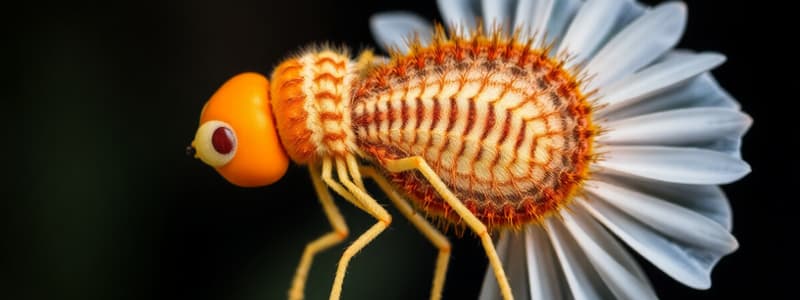Podcast
Questions and Answers
Which of the following characteristics is true for bacteria in Kingdom Monera?
Which of the following characteristics is true for bacteria in Kingdom Monera?
- They have a defined nucleus.
- They reproduce asexually. (correct)
- They contain 80S ribosomes.
- They have membrane-bound organelles.
What is the first word in a binomial name called?
What is the first word in a binomial name called?
- Family
- Species
- Nomenclature
- Genus (correct)
Which type of bacteria is not classified under Kingdom Monera?
Which type of bacteria is not classified under Kingdom Monera?
- Eukaryotes (correct)
- Eubacteria
- Cyanobacteria
- Archaebacteria
What is systematics primarily concerned with?
What is systematics primarily concerned with?
What does a cladogram illustrate?
What does a cladogram illustrate?
Who proposed the three domains of life?
Who proposed the three domains of life?
What is the primary focus of chemotaxonomy?
What is the primary focus of chemotaxonomy?
Which method uses DNA sequences to identify species?
Which method uses DNA sequences to identify species?
What is the correct way to write a scientific name when typed?
What is the correct way to write a scientific name when typed?
What type of bacteria are known as extremophiles?
What type of bacteria are known as extremophiles?
Which of the following is NOT a mode of reproduction for bacteria in Kingdom Monera?
Which of the following is NOT a mode of reproduction for bacteria in Kingdom Monera?
The author who proposed the binomial nomenclature is:
The author who proposed the binomial nomenclature is:
Which statement accurately describes phylogeny?
Which statement accurately describes phylogeny?
How many letters can the generic and specific names have in binomial nomenclature?
How many letters can the generic and specific names have in binomial nomenclature?
Why are a horse and an ass considered different species?
Why are a horse and an ass considered different species?
What is the goal of numerical taxonomy?
What is the goal of numerical taxonomy?
What are the characteristics that define Eubacteria?
What are the characteristics that define Eubacteria?
Which of the following is a type of autotrophic bacteria?
Which of the following is a type of autotrophic bacteria?
What type of protists are diatoms classified as?
What type of protists are diatoms classified as?
What is a common feature of pathogenic bacteria?
What is a common feature of pathogenic bacteria?
Which of the following organisms can cause malaria?
Which of the following organisms can cause malaria?
Which type of protist is characterized by the presence of silica in its cell wall?
Which type of protist is characterized by the presence of silica in its cell wall?
What structure helps flagellated protozoans to move?
What structure helps flagellated protozoans to move?
Which group of organisms are known to be saprophytic and found on decaying leaves?
Which group of organisms are known to be saprophytic and found on decaying leaves?
Which of the following diseases is caused by a virus in animals?
Which of the following diseases is caused by a virus in animals?
What is a distinguishing feature of viroids compared to viruses?
What is a distinguishing feature of viroids compared to viruses?
In a lichen, which partner is responsible for providing shelter and minerals?
In a lichen, which partner is responsible for providing shelter and minerals?
Which of the following is NOT a characteristic of viruses?
Which of the following is NOT a characteristic of viruses?
What role do lichens play in the environment?
What role do lichens play in the environment?
What is a distinguishing feature of euglenoids compared to typical plant cells?
What is a distinguishing feature of euglenoids compared to typical plant cells?
Which of the following is NOT a characteristic of the Kingdom Plantae?
Which of the following is NOT a characteristic of the Kingdom Plantae?
What structure forms the body of fungi?
What structure forms the body of fungi?
Which type of hyphae lacks septa and commonly shows a multinucleate structure?
Which type of hyphae lacks septa and commonly shows a multinucleate structure?
What role do fungi such as Penicillium serve in medicine?
What role do fungi such as Penicillium serve in medicine?
Which of the following groups of fungi is known as Imperfect Fungi?
Which of the following groups of fungi is known as Imperfect Fungi?
Which of the following is NOT a method of reproduction in fungi?
Which of the following is NOT a method of reproduction in fungi?
Which of the following plants are classified as insectivorous but fall under semi-autotrophic categories?
Which of the following plants are classified as insectivorous but fall under semi-autotrophic categories?
Flashcards are hidden until you start studying
Study Notes
Systematics and Taxonomy
- Systematics is the study of organism diversity and their relationships.
- Taxonomy is the classification of organisms based on rules and principles.
- Classification involves grouping organisms based on a plan, with ranks forming a hierarchy.
- Chemotaxonomy uses chemical characteristics for classification, like cell wall composition.
- Numerical taxonomy compares organisms based on many characteristics from different fields of biology.
- Cladograms show hypothetical relationships between organisms and their ancestors.
- Phylogeny considers both morphology and evolutionary relationships between organisms.
- DNA barcoding identifies species using DNA sequences from tissue samples.
Binomial Nomenclature
- Carl Linnaeus proposed the Binomial Nomenclature system.
- Binomial Nomenclature comprises two words: Genus (first word, capitalized noun) and species (second word, lowercase adjective).
- Both names are written in italics or underlined if handwritten.
- The author who named the organism is also written in full or abbreviated form.
- The system avoids confusion caused by vernacular names, which vary by region.
Five Kingdom Classification
- The Five Kingdoms were proposed by R.H. Whittaker.
- Kingdom Monera:
- Lacks membrane-bound organelles (chloroplasts, mitochondria, etc.).
- 70S ribosomes.
- Reproduction via asexual methods like binary fission, budding, or rarely, sexual (conjugation).
- Bacteria shapes include: coccus (spherical), bacillus (rod-like), vibrio (comma-shaped), spirillum (spiral).
- Two types of bacteria based on evolution:
- Archebacteria: Extremophiles (halophiles, thermophiles) found in harsh environments.
- Eubacteria: True bacteria with peptidoglycan cell walls, can be autotrophs or heterotrophs.
- Useful bacteria: Lactobacilli (curdling milk), Azotobacter (nitrogen fixation), Streptomyces (antibiotic production).
- Harmful bacteria: Cause diseases like typhoid, cholera, tuberculosis, and tetanus.
- Mycoplasma: Smallest living organisms without cell walls, resistant to antibiotics, can be pathogenic.
- Kingdom Protista:
- Connects unicellular Kingdom Monera to eukaryotic Kingdoms Plantae, Fungi, and Animalia.
- Plant-like Protists (Chrysophytes / Phytoplanktons): Photosynthetic, major ocean producers.
- Diatoms: Cell wall made of silica, two fitting covers.
- Diatomaceous earth: Granular sediment from diatom shells, used in polishing and filtration.
- Animal-like Protists (Protozoans): Lack cell walls.
- Amoeboid Protozoans: Move with pseudopodia (e.g., Amoeba, Entamoeba).
- Flagellated Protozoans: Move with flagella (e.g., Trypanosoma).
- Ciliated Protozoans: Move with cilia (e.g., Paramoecium).
- Sporozoan Protozoans: Parasitic, produce spores (e.g., Plasmodium).
- Dinoflagellates: Mostly marine, photosynthetic, cellulose cell walls, Gonyaulax causes "Red Tides."
- Fungi-like Protists: Saprophytic, form plasmodium, produce spores.
- Euglenoids: Lack cell walls, have a pellicle (protein layer), autotrophic in light, heterotrophic in darkness.
- Kingdom Plantae:
- Mostly autotrophs, some are semi-autotrophic (insectivorous) or heterotrophic (parasitic).
- Divided into Cryptogams (non-flowering plants) and Phanerogams (flowering plants).
- Kingdom Fungi:
- Fungal body called mycelium, made of hyphae.
- Hyphae can be septate (divided) or aseptate (undivided).
- Multinucleate coenocytic hyphae are common (undivided hyphae with many nuclei).
- Cell wall made of chitin or fungal cellulose.
- Reproduction can be sexual or asexual (fragmentation, fission, budding).
- Heterotrophic with extracellular digestion, relying on dead organisms for food.
- Some are parasitic, predatory, or symbiotic.
- Useful Fungi: Food (mushroom, morels, truffles), baking/brewing (Saccharomyces), antibiotic production (Penicillium), research (Neurospora).
- Harmful Fungi: Disease causing (Albugo, Puccinia, Ustilago).
Classification of Fungi
- Kingdom Fungi:
- Deuteromycetes (Imperfect Fungi): Sexual reproduction not known, mycelium aseptate and coenocytic. Example: Alternaria.
- Phycomycetes (Algal Fungi): Mycelium aseptate and coenocytic. Example: Rhizopus.
- Ascomycetes (Sac Fungi): Mycelium septate. Examples: Penicillium, Neurospora.
- Basidiomycetes (Club Fungi): Mycelium septate. Examples: Plant diseases like rusts, smuts.
Viruses and Viroids
- Viruses:
- Genetic material (DNA or RNA) enclosed in a protein coat (capsid).
- Cause diseases in plants and animals.
- Plant diseases: Leaf curling, yellowing, mosaic formation.
- Animal diseases: Foot and mouth disease, smallpox, mumps, herpes, common cold, AIDS, COVID.
- Viroids:
- Low molecular weight RNA, lack protein coat, smaller than viruses.
- Cause potato spindle tuber disease.
- Differences between viruses and viroids:
- Viruses have a capsid, viroids do not.
- Viruses are larger than viroids.
- Viruses can have DNA or RNA, viroids always have RNA.
Lichens
- Lichens: Symbiotic association between an algae (phycobiont) and a fungus (mycobiont).
- Algae provide food, fungus provides shelter, water, and minerals.
- Found in extreme environments, sensitive to pollution, considered pollution indicators.
Studying That Suits You
Use AI to generate personalized quizzes and flashcards to suit your learning preferences.




